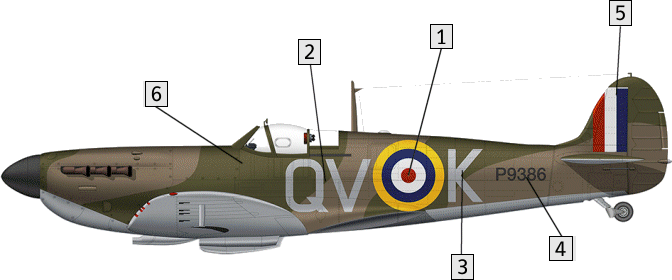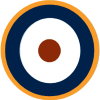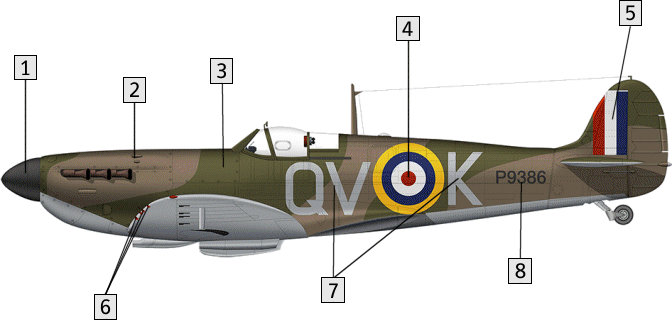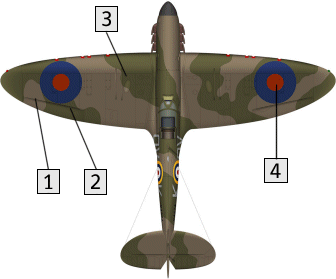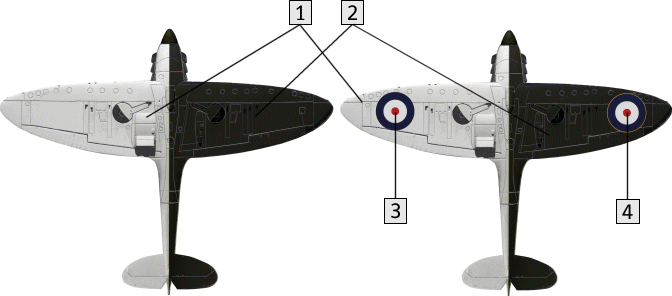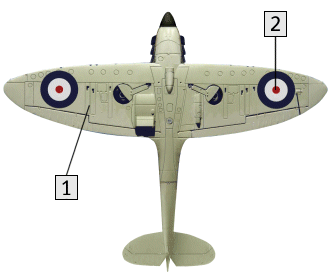|
During the Battle of Britain the standard camouflage for the fuselage and upper surfaces of Fighter Command aircraft would remain the same throughout the battle. It would be the undersides of the aircraft that would be subject
to change. This article covers the camouflage colours and markings that appeared on Fighter Command's aircraft.
For this article we have used the Supermarine Spitfire as the example aircraft, as this was one of the
two main types used by Fighter Command during the Battle of Britain. We have only detailed the official
colours that should have been used, as squadrons may have done their own version of camouflage, or issues with the supply of correct paint led to variations in colour.
Aircraft Markings
Royal Air Force Roundel - This would normally be the early war modified (1939 - 1941) roundel (right) or, as seen on this aircraft, the fuselage (1940 – 1942) roundel.
Squadron Code - This identified the squadron the aircraft belonged to. So in this instance, the letters QV let us know this is a No. 19 Squadron aircraft.
Aircraft Identity Letter - This identified the aircraft within the squadron.
Aircraft Registration Number - This identified the individual aircraft. So, in the case of this aircraft, (P9386), we can find out that it joined No. 19 Squadron in May 1940 before joining No. 152 Squadron in September 1940.
Fin Flash – This helped to aid aircraft identification.
Aircraft Insignia - Although not on this aircraft, insignia was sometimes added to identify a squadron, for example No. 302 (Polish) Squadron had the Polish Air Force roundel (right) painted on their aircraft.
Another type of insignia added was rank pennants. These represented the rank of the pilot flying the aircraft.
Air Marshal
 |
Air Vice-Marshal
 |
Air Commodore
 |
Group Captain
 |
Wing Commander
 |
Squadron Leader
 |
|
Aircraft Camouflage – Fuselage
During the Battle of Britain the colours of the fuselage and upper surfaces of Fighter Command aircraft underwent little change and would be standard colours throughout the battle.
 |
Spinner |
 |
 |
Fuselage |
 |
 |
Fuselage |
 |
 |
Fabric |
 |
|
|
|
Placed over the machine-guns to stop them freezing, if this was ripped it meant the guns had been fired and needed rearming.
|
|
 |
Squadron Code |
 |
 |
Aircraft Registration |
 |
Aircraft Camouflage- Upper Surfaces
 |
Upper Surface |
 |
 |
Upper Surface |
 |
|
Not added to this aircraft, but a small yellow patch was added to the wing, which the pilot could see. If this changed colour it meant that a gas attack had taken place.
|
Aircraft Camouflage- Underside
Whilst the fuselage and upper surface camouflage of Fighter Command aircraft stayed the same throughout the battle, the underside of the aircraft would undergo change. Black and white undersides, to aid identification of friendly
aircraft, was the most prominent scheme, and this appeared in two guises, with and without roundels.
 |
Underside |
 |
 |
Underside |
 |
June 1940 saw the black and white undersides begin to be replaced by a sky underside.
 |
Underside |
 |
However, due to a shortage of the correct paint, variants of the sky underside appeared to begin with, but by August 1940 the correct sky camouflage became more prevalent.
< Back to articles
|
|
|
|
Quick Search
Feedback
Spotted an error? Or just have a comment or suggestion about Classic Warbirds?
Let us know.
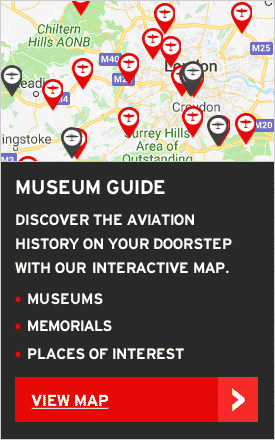
|
|

